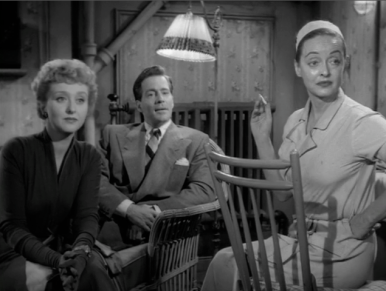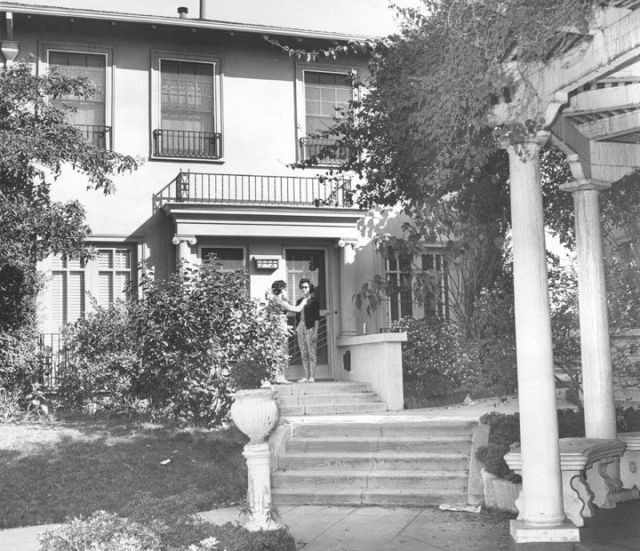
I’ve always said that if I could have witnessed the shooting of any scene from any classic movie, it would be ‘The Trolley Song’ scene from Meet me in St Louis (1944). It is without a doubt my favorite musical number of all time. This, to me, is the pinnacle of a musical number. And the really impressive thing about it is that, it just seems so natural. So ‘in the moment’. It’s not as visually stunning as a Busby Berkeley number, and there’s no dance routine at all. It’s just a wonderful piece of musical joy. And it doesn’t hurt that the whole scene is led by possibly the most talented woman of the 20th Century, the amazing Judy Garland. She has never looked so happy and beautiful, and in this movie, she proves yet again that there was nothing she couldn’t do. And this scene was all done in one take. One take! I just find that incredible. The whole movie is fantastic (it also gave us the endlessly covered ‘Have yourself a Merry little Christmas’) but ‘The Trolley Song’ will always take the cake for me.

 The story about Lana Turner being discovered by a producer while she was drinking a soda in downtown Los Angeles is one of the most famous Hollywood stories of all time. On that day in 1937, at the Top Hat Cafe in Sunset Blvd, The Sweater Girl was born and a Hollywood legacy was in the making. It only stands to reason that a stunningly beautiful girl who had had such a notorious start and career would end up embroiled in one of the most talked-about Hollywood scandals of all time. It all started in 1957, when she met mobster Johnny Stompanato. She became enamored with him, but his possessive behavior quickly began to show. Their relationship consisted mainly of arguments, abuse and reconciliations. Then, on the night April 4th, 1958, he went to her house in Beverly Hills and the two began arguing in her room. Lana’s 14-year-old daughter Cheryl became nervous and decided to do something, as she feared for her mother’s safety. She went downstairs and into the kitchen, grabbed a knife and ran upstairs. She banged on her mother’s bedroom door but got no response. When she finally opened the door, Cheryl walked in and as Johnny was charging towards Lana, she stabbed him. Before he fell on the floor, he reportedly said ‘My God, Cheryl, what have you done?’. He was dead by the time the ambulance arrived. This was a massive scandal in Hollywood and the trial went on forever. Eventually, no criminal charges were filed against Cheryl Crane, since she was only 14. She now lives in Palm Springs and has written several books about her mother and ‘the happening’, as it became known. As for Lana, she is now regarded as a Hollywood legend. She died in 1995 and has a star on the Holllywood Walk of Fame.
The story about Lana Turner being discovered by a producer while she was drinking a soda in downtown Los Angeles is one of the most famous Hollywood stories of all time. On that day in 1937, at the Top Hat Cafe in Sunset Blvd, The Sweater Girl was born and a Hollywood legacy was in the making. It only stands to reason that a stunningly beautiful girl who had had such a notorious start and career would end up embroiled in one of the most talked-about Hollywood scandals of all time. It all started in 1957, when she met mobster Johnny Stompanato. She became enamored with him, but his possessive behavior quickly began to show. Their relationship consisted mainly of arguments, abuse and reconciliations. Then, on the night April 4th, 1958, he went to her house in Beverly Hills and the two began arguing in her room. Lana’s 14-year-old daughter Cheryl became nervous and decided to do something, as she feared for her mother’s safety. She went downstairs and into the kitchen, grabbed a knife and ran upstairs. She banged on her mother’s bedroom door but got no response. When she finally opened the door, Cheryl walked in and as Johnny was charging towards Lana, she stabbed him. Before he fell on the floor, he reportedly said ‘My God, Cheryl, what have you done?’. He was dead by the time the ambulance arrived. This was a massive scandal in Hollywood and the trial went on forever. Eventually, no criminal charges were filed against Cheryl Crane, since she was only 14. She now lives in Palm Springs and has written several books about her mother and ‘the happening’, as it became known. As for Lana, she is now regarded as a Hollywood legend. She died in 1995 and has a star on the Holllywood Walk of Fame.


 You can walk down any street in Los Angeles and be sure that at some point in Hollywood history, something happened there that still gets people talking after all these years. Take, for instance, South Alvardo Street. There is a parking lot where the Alvarado Court Apartments once were. Years before they were demolished, there was a murder in one of those lavish bungalows. 1922 was the year. William Desmond Taylor was the victim. You’ll have read his name on countless Top 10 Countdowns about Hollywood’s most infamous scandals of The Golden Age, I’m sure, and undoubtedly at the very top of the list, more often than not. His murder shocked Los Angeles and indeed all of America. He was a film director, producer, and actor, and like all of them, he didn’t really lead a quiet life. On February 1, 1922, he and Mabel Normand were having a private party at his house. At 7.45pm he walked her to her car and at 8pm he was dead. Shot in the back. What happened in those 15 minutes remains a mystery to this day. There have been many, many theories, but nothing has come of any of them. As you can imagine, the suspect list is pretty big: Mary Miles Minter, a young actress who was supposedly going to be the next Mary Pickford and with whom Desmond Taylor was involved. She was apparently quite smitten with him and might have killed him out of jealousy; Edward Sands, his houseman, who, by all accounts, was a sociopath. Before being hired by William Desmond Taylor, he had prior convictions for forgery, embezzlement and fraud; Charlotte Shelby, who is often thought to have indeed been the killer of William Desmond Taylor. She was the mother of Mary Miles Minter and had the well-known habit of threatening any man who came near her daughter; Mabel Normand herself, who was never a serious suspect, but who was very keen on getting her love letters back from his house. This raised some suspicion at the time, and she was a suspect, but it is safe to say that she most definitely did not kill him. In fact, before she died in 1930, she reportedly said ‘I wonder who killed poor Bill Taylor?’; Margaret Gibson, a silent movie actress, who confessed on her deathbed that she was the one who killed him. However, this type of confession was made by many, many people over the years and no one could ever be sure who was teling the truth. And since they and all the witnesses have passed away, his murder will continue to baffle readers and Hollywood enthusiasts for years to come.
You can walk down any street in Los Angeles and be sure that at some point in Hollywood history, something happened there that still gets people talking after all these years. Take, for instance, South Alvardo Street. There is a parking lot where the Alvarado Court Apartments once were. Years before they were demolished, there was a murder in one of those lavish bungalows. 1922 was the year. William Desmond Taylor was the victim. You’ll have read his name on countless Top 10 Countdowns about Hollywood’s most infamous scandals of The Golden Age, I’m sure, and undoubtedly at the very top of the list, more often than not. His murder shocked Los Angeles and indeed all of America. He was a film director, producer, and actor, and like all of them, he didn’t really lead a quiet life. On February 1, 1922, he and Mabel Normand were having a private party at his house. At 7.45pm he walked her to her car and at 8pm he was dead. Shot in the back. What happened in those 15 minutes remains a mystery to this day. There have been many, many theories, but nothing has come of any of them. As you can imagine, the suspect list is pretty big: Mary Miles Minter, a young actress who was supposedly going to be the next Mary Pickford and with whom Desmond Taylor was involved. She was apparently quite smitten with him and might have killed him out of jealousy; Edward Sands, his houseman, who, by all accounts, was a sociopath. Before being hired by William Desmond Taylor, he had prior convictions for forgery, embezzlement and fraud; Charlotte Shelby, who is often thought to have indeed been the killer of William Desmond Taylor. She was the mother of Mary Miles Minter and had the well-known habit of threatening any man who came near her daughter; Mabel Normand herself, who was never a serious suspect, but who was very keen on getting her love letters back from his house. This raised some suspicion at the time, and she was a suspect, but it is safe to say that she most definitely did not kill him. In fact, before she died in 1930, she reportedly said ‘I wonder who killed poor Bill Taylor?’; Margaret Gibson, a silent movie actress, who confessed on her deathbed that she was the one who killed him. However, this type of confession was made by many, many people over the years and no one could ever be sure who was teling the truth. And since they and all the witnesses have passed away, his murder will continue to baffle readers and Hollywood enthusiasts for years to come.
